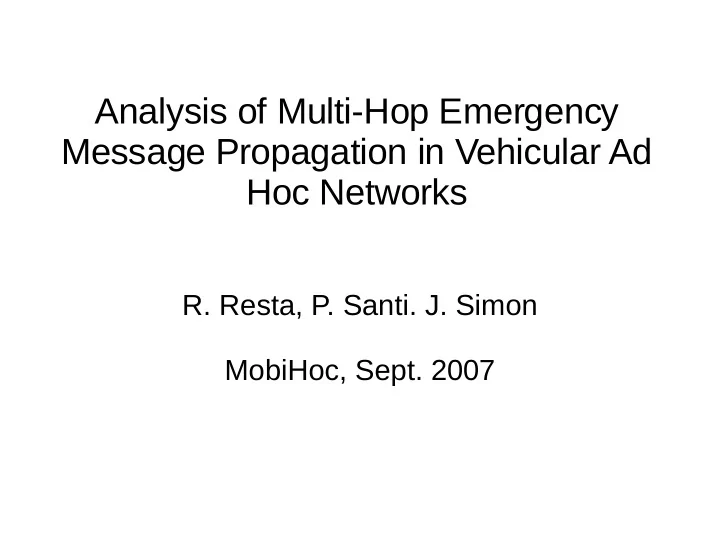

Analysis of Multi-Hop Emergency Message Propagation in Vehicular Ad Hoc Networks R. Resta, P. Santi. J. Simon MobiHoc, Sept. 2007
Motivation ● Road safety may be the top application for many groups, auto makers, governments, (insurance companies?) ● Differentiated packet forwarding services may be needed for different levels of criticality. – Dynamic road map – Accident reporting, warning
Motivation ● Emergency messages may need to reach cars following as fast as possible – Accidents are often a matter of sub-seconds ● If a vehicle V has received an emergency message, it should be very likely that the vehicles between V and the originator have received the message. – Accidents are often caused by a single vehicle which is not situation-aware of
In other words ● By when can a vehicle V at D distance away from the originator receive an emergency message? ● When V receives an emergency message, how much percentage of the vehicles in between have probably received the message already?
Two dominant factors ● 1-hop reliability – Adjustable by the levels of radio transmission power ● Smart dissemination protocol? ● Third? ● Which factor do we need to focus to realize the two goals; fast dissemination, high coverage
Simplified models ● Cars are equally spaced ● Emergency messages are broadcast ● Protocol round ● Interference model: only one speaker within a transmission range ● Channel model?
Channel model
Problem formulation
Analytical model ● 000011001100111 ● Three strategies – GLOBAL – IDEALIZED – IMGLOBAL
GLOBAL ● Centralized algorithm ● Needs global knowledge ● Input: Sn(t) ● Output: a set of transmitters for next rounds in a way that interference is minimized
IDEALIZED ● The leftmost 1-node transmits next, always, to reach cars following as fast as possible ● 0-nodes in between turn to a 1-node with probability p
IMGLOBAL
Discussion ● Three traffic scenarios, inter-vehicle diatance – Light: 60m – Medium: 30m – Heavy: 15m ● Transmission range: 125m ● Interference range: 250m
Decomposition of T ● A node V needs to be within a transmission range of another node to receive a message with a probability p. ● Until then, the probability of V to be a 1-node remains 0 ● Once V is within a transmission range of another node, a process begins at the node with a probability p’ < p ● Tmin is the time V needs to be in the transmission range of another node
Dependence on distance
Dependence on distance
Dependence on time
Dependence on channel reliability
Simulation
Simulation
Recommend
More recommend